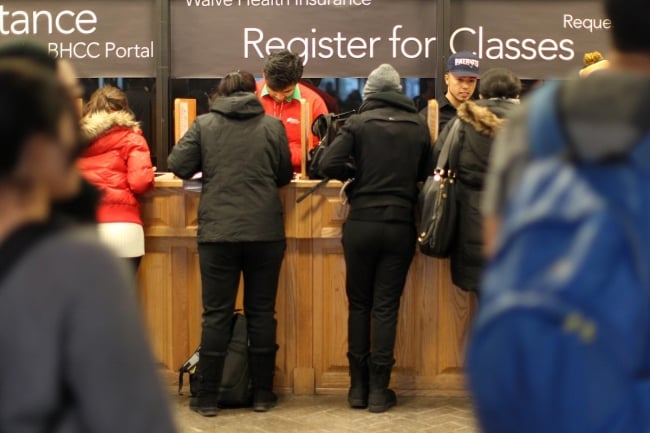You have /5 articles left.
Sign up for a free account or log in.

Some 36 million Americans started college but stopped before getting a degree. The Degrees When Due program aims to get those students closer to finishing.
Boston Globe/Contributor/Getty Images
A report published Monday about a three-year national initiative to boost completion for students who stopped attending college before they earned degrees calls on higher ed institutions and federal, state and local governments to do more to lure students back to college and push them over the finish line.
The Degrees When Due (DWD) initiative, led by the Institute for Higher Education Policy, or IHEP, worked with more than 200 participating colleges in 23 states between 2018 and 2021 to find ways to assist students who interrupted their education and get them back on track to earning degrees or training certificates. Much of the plan was centered on underserved groups—students of color and those from low-income backgrounds, first-generation students and older students—and the institutions that serve them.
“We call on every institution, system, and state, as well as policymakers at the federal level [to] help ensure that all students achieve their higher education goals,” the report says.
According to the authors of the 52-page report, there are 36 million students in the United States who have some college education but did not complete college—a category known as some college, no degree (SCND)—and more than three million of them are “near completers” who completed at least two years of coursework.
The DWD program assisted institutions in removing barriers that keep students from returning to or finishing college. Those efforts involved the institutions auditing students’ transcripts to determine who already had enough credits to complete coursework and earn a degree or was close enough to completing their studies to justify returning to college to do so. The report also uncovered several reasons why students stopped out—including financial difficulties, inability to attend college while working and supporting families, and feeling that the institutions were not invested in or supportive of them and their circumstances.
The initiative illuminated how much those challenges affected students’ decisions on whether to return to college, said Barbara Henry, assistant vice president for nontraditional and military student services at Bowling Green State University in Ohio.
“Students with some college, no degree need to be connected,” Henry said in the report. “They need to be connected to the institution. They need to be connected to a very clear pathway to degree completion. And then they need someone there every step of the way helping them. So that’s an intense investment in human capital. But I believe that it is the way we are going to make a tremendous difference for this population of students.”
Those students are disproportionately from underserved populations, said Mamie Voight, president and CEO of IHEP, who noted that “about half” of the students whose needs were addressed through the initiative were people of color, and 46 percent were from low-income backgrounds.
“The work was really grounded in equity,” Voight said.
The focus on those underserved populations differentiated the initiative from a wave of similar studies of returning college students published in the last six months, said Mike Krause, a longtime advocate for returning students and adult learners and former executive director of the Tennessee Higher Education Commission.
“First and most important, serving adult learners is in itself an important aspect to closing the inequity gap,” Krause said, adding that focusing on and serving only students who have followed traditional educational paths will not fix the problem.
The report was “transformational in the sense that the adult learner conversation and the equity conversation should be linked,” he said. It “was perfect, and really called out some important things that needed to be heard.”
Piper Hendricks, IHEP’s vice president of communications and external affairs, said it was important for the report to underline that postsecondary outcomes are inequitable.
“The fact that we’re still seeing these inequitable outcomes in 2022 is unacceptable,” she said. “The inequities deepened during the pandemic. It feels both like a time to recognize the inequities and that we have the tools to correct them.”
The initiative was not originally planned to last three years, but the approach changed in response to the COVID-19 pandemic. DWD began in 2018 with 44 institutions in eight states, but it shifted direction and expanded its scope a year later as it came across the funding, technology and staff shortage challenges the institutions were experiencing. Initiative leaders developed an online degree-mining tool, a set of strategies to make it easier for colleges to overcome the outdated technology and equipment and staff shortages that impeded the program’s efforts to put its plans for students in place.
The number of minority-serving institutions participating in the initiative rose from 11 to 45 between the first and second years as program leaders pushed their private and public partner organizations to spread the word about the large numbers of students from disadvantaged groups that the program could help. The institutions that struggle to retain students and to entice those who left to return are often badly underresourced, and they disproportionately serve marginalized students, said Hendricks.
“So often, we’re asking the institutions who are the least resourced to do the most work,” she said.
The economic damage from the pandemic and the social and economic inequities revealed in the aftermath of the murder of George Floyd prompted another change of direction in 2020. More institutions joined the initiative, trying to help students who could no longer afford to attend college, who lost jobs and did not have access to the technology needed for remote learning.
Hendricks said one outcome of the initiative was understanding how the traditional narrative about the path of a college education—enter straight out of high school, attend for four uninterrupted years, exit with a diploma—needed to be erased and rewritten.
“It’s so true—the larger narrative impacts how educators are thinking, but it also impacts how students are thinking,” she said.
The report recommends that institutions and governments remove obstacles—such as outdated graduation requirements, financial holds on degrees, bureaucratic policies and requirements, and problematic technology—that keep students from completing college. It also recommends institutions conduct more degree audits, take it upon themselves to manage the credit transfer process instead of making students do it alone and improve funding in several areas that would clear a path for students to return and finish.
“Whether through action or inaction, failure to support today’s students limits their social and economic mobility and disadvantages us all,” the report concluded.
Voight said she has seen encouraging federal and state financial legislation proposed in recent months that would give institutions the money they need to continue the work described in the report.
“But those larger sums haven’t come to fruition yet, so we’ve continued to advocate for the level of support we know is necessary,” she said.








